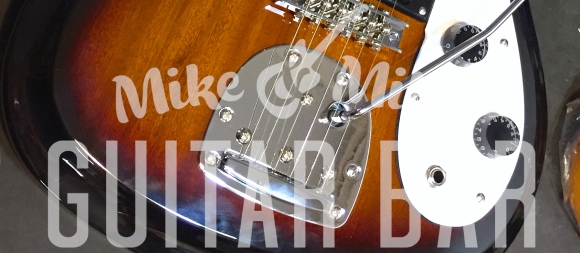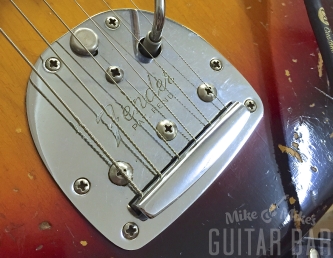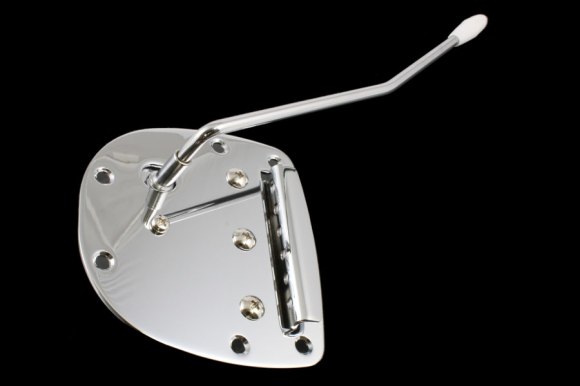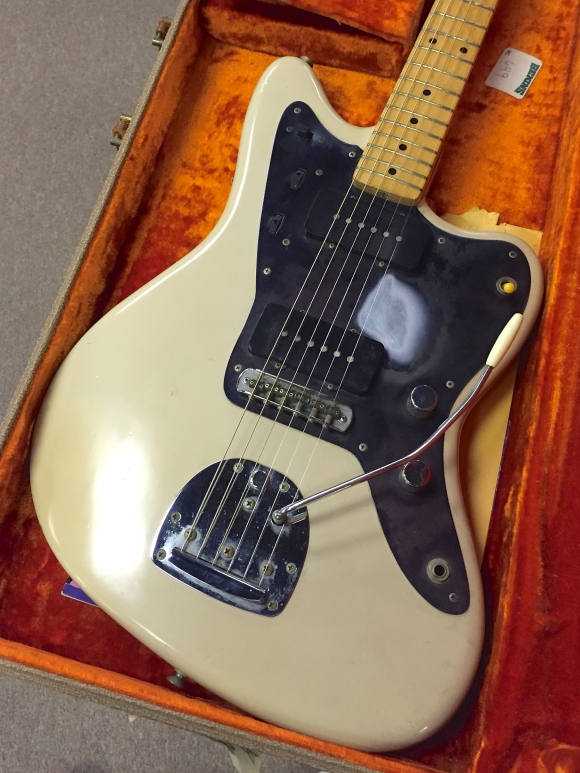I spend the bulk of my professional life thinking about offset guitars, from the next way in which I’ll be able to explain solutions to the myriad perceived bridge issues, to my idea of the perfect Jaguar, to mods and possible set up techniques I’d like to explore on one of my own. These guitars have been a huge part of my career, and I’m happy to say that recently I’ve discovered that I have a nickname among some enthusiasts: “The Jazzmaster Guy”.
Yes, dear reader, you likely know already how obsessed I am with these models, and in the same way that some proudly identify with a political party or religion, I wear my love of these quirky guitars as a badge of honor. If elections were held to determine the supreme guitar ruler of the world, I would firmly be in the Offset Party. I would totally rock a “Jazzmaster 2016” or “Jaguar 2016” bumper sticker. In fact, that might be worth putting some effort into.
Recently Summer NAMM took over the Music City Center in Nashville as well as our Facebook, Twitter, and Instagram feeds. Gear lovers had a lot to look forward to, with new offerings from boutique and indie guitar, pedal, and amp makers as well as updated models from the big boys, and even if you weren’t able to attend in person (like me) there were plenty of goodies showing up online to satisfy even the most stodgy of enthusiasts. Among said goodies were plenty of models in the offset tradition, which is something that should have elicited more excitement in me than I actually felt.
It’s true: everyone makes an offset guitar these days, and how could we begrudge them that? These guitars have never been more popular, what with the spate of indie bands, aftermarket parts like the Mastery Bridge, and Nels Cline’s mind-altering musicianship, new Jazzmaster and Jaguar models (as well as variations on the theme!) are flooding the market at rates never before seen or anticipated. What was once a bargain-barrel, “crappy” guitar is now every bit as coveted and hallowed as some of the other most successful and idolized guitar models out there.
But with all of the complaints levied against these models (all of which we disputed and dispelled in our Demystifying series) one would expect that new offerings would perhaps understand not only the setup techniques involved in making these guitars play as Leo Fender intended, but also the very real affect of sub-par parts on the tone and functionality of these amazing, misunderstood instruments.
And that’s what concerns me about these upmarket models and fresh takes on famous designs, that there appears to be a disturbing trend in the “boutique” guitar market far more pervasive than relic finishes, self-tuning guitars, and ultra-hot gimmicky pickups:
$2000 guitars with cheap import hardware.
Offset Apart
Many builders these days have homed in on the hot, hot, hot market share the offset body design has carved out for itself. Never more popular or readily available, the Jazzmaster and Jaguar-like body designs invading stores and internet forums alike are often as enticing as they are expensive. Offsets are being turned out in huge numbers these days, and so even small builders are looking to remain competitive in this not-so-niche market, and in order to stay that way, some builders are quietly installing inexpensive hardware on their guitars. And because we’re seeing this practice so often, these expensive custom guitars don’t perform nearly as well American reissues offered by the big company with the F-logo. I find that to be inexcusable, and too often, guitar makers are ignoring what I would argue is the most important piece of hardware on the guitar in terms of tuning stability: the offset vibrato tailpiece.
If you’ve read our Demystifying series, then you know that, when properly set up, Leo Fender’s offset vibrato design works flawlessly. Seriously, take a moment to read those articles, then come back to this one with your mind blown, and thus, more open. The offset vibrato is so popular right now for a reason, and that reason is, it’s stable as hell. When well-maintained, I can do more and get more out of the offset vibrato than I can with just about any other unit on the market, and although it may not ‘dive bomb’ the way a Floyd Rose does, how many non-locking trems do you know of where you can depress the bar the whole way, strings flopping about, then release and have it come straight back into tune? (For the record, I also love Gibson’s equally maligned Lyre Vibrola, Bigsbys, Rickenbacker’s Accent, and the tailpieces found on old Silvertone guitars. Sorry for answering my own question.)
But hold on a sec, the above statements come with a disclaimer: I’m only referring to vintage and US reissue tremolo units. There is no import part on the market that works as intended.
I’m quite honestly shocked at the number of high end offset guitars at SNAMM equipped with the unbranded offset vibrato, a unit that can be easily obtained from many parts suppliers yet is never worth even its modest cost. The reasons I’m so down on the ubiquitous, no-name import trem unit is that the parts are made from pot metal, poorly machined, and are generally bulkier in design. They also happen to have arms with the least graceful bend imaginable, something that I’d contend is as much a part of the feel of the trem as the spring.
See, not only are there issues with arms spinning freely, collets breaking and never quite locking-in properly on those units, they also just don’t stay in tune as well as those made in the America. Parts that don’t fit properly together mean that the unit won’t return to pitch or “zero out” perfectly. They feel cheap, and comparing one of these import trems with the real thing, one can plainly see the stark difference in quality between them.
Recently, my pal Jessica Dobson of Deep Sea Diver brought in a new guitar for a setup and to install new pickups, and as part of a setup, I always ensure that the trem unit functions smoothly and accurately. In the case of this instrument and many like it, the vibrato wouldn’t return to pitch even when properly set up. I removed and dismantled the unit, and saw something that I’d seen many times before.
 In viewing this photo from my Instagram feed, you should be able to see that the pivot plate on this Asian-import trem is sloppily manufactured, and it’s not just this particular one! Every single one of these I’ve ever worked on is malformed in some way, leaving the hope of tuning stability a pipe dream at best. Now, this can be corrected to some extent by doing as I did here, grinding away the excess material until the plate was left with sharp edges and equally smooth contact points. And while this does ensure that the trem works much, much better than it did, weak springs and inferior materials will continue to cause issues much farther down the road.
In viewing this photo from my Instagram feed, you should be able to see that the pivot plate on this Asian-import trem is sloppily manufactured, and it’s not just this particular one! Every single one of these I’ve ever worked on is malformed in some way, leaving the hope of tuning stability a pipe dream at best. Now, this can be corrected to some extent by doing as I did here, grinding away the excess material until the plate was left with sharp edges and equally smooth contact points. And while this does ensure that the trem works much, much better than it did, weak springs and inferior materials will continue to cause issues much farther down the road.
Another mark against the import unit: bad metal sounds bad.
A Call to Trem Arms
If you’re a guitar maker offering a Jazzmaster-type model (or any model with that particular bridge and tailpiece combo) then I completely understand that you can’t just put a Fender-branded part on your guitar. In that regard, the no-name, unbranded import vibrato seems like a good alternative, and one that’s easy to relic to hell and back, if that’s your bag. The thing is, because they’re so poorly-made, you may be offering a guitar with a flaw right out of the gate. But there is hope!
One option would be purchasing the U.S.-made ‘real thing’ and replacing the face plate. Companies like Faction Electric Guitars offer stainless steel plates (designed by our pal Paul Rhoney) that would suit this purpose well. Sure, that’s an added expense, but if you’re already charging $1800-$2500 for a guitar, well, it’s a worth while one.
An even better option? Investing in the Mastery Vibrato, a unit that’s free of ties to the California manufacturer with the familiar name that works perfectly and is perhaps the closest in feel and tonality to the units found on vintage offset guitars, and as many of us offset aficionado will tell you, they’re the cream of the crop. Woody designed this piece as an upgrade to the original, with the a new carbon steel spring meant to feel and perform as the originals, low-profile screws that won’t chew through your strings, and a pivot plate that runs the entire length of the string anchor plate. Sturdy, solidly-built, and tonally brilliant, this all adds up to the perfect vibrato for your equally well-made and attractive instruments.
If you’re building your own guitar from parts and you don’t have the coin to drop on upgraded or vintage units, you can find Fender AVRI trems in the $50-60 range, and you can even find ‘aged’ ones on eBay. The no-name unit goes for $35 over at Allparts but don’t say I didn’t warn you. Unfortunately, at this time the import unit is the only option for those in need of gold hardware.
Now, the purpose of this article isn’t to call out any specific builders out there, so I’m not going to include the names of guitar makers that use the dreaded “no-name” vibrato. Instead, here’s a list of some of my favorite builders that, instead of attaching subpar parts to their instruments, go the extra mile and dollar to install the precision-machined Mastery Vibrato. These are builders that care about quality that you can buy from and know that your instrument will perform as promised every single time.
In alphabetical order:
Ayers
BilT
Collings
Creston
Deimel
Echo Park
Kauer
Rhoney
That’s all I could think of right now, but I’ll be sure to update this post once my other guitar-building friends read this and yell at me for forgetting them. I’ll deserve that much at least, I’m sure.
Anyway, this one’s the only unbranded trem I’ve ever liked, found on Freddie Tavares’ prototype ’58 Jazzmaster in Desert Sand with a huge maple Stratocaster neck and a sweet black anodized guard. Special thanks to Mark Agnesi of Norman’s Rare Guitars for letting me have an unforgettable hour with this thing. What. A. Guitar. Expect a short article about that hour in the future!





Best advice I ever took: buying a US made unit for mine.
Great commentary!
I’ve been working on a guitar design with my pal mel Bergman in the offset flavor…we’ve prototyped a trem that works better than the f-brand, all designed and made here in California
Go USA!
One time I was checking my instagram and the girlfriend was like: “Who’s that guy?” And I was like: “Oh, he’s like the Jazzmaster guru.”
Great article. I’ve learned so much from this site!
THAT IS THE COOLEST THING EVER!!!
Great article. What is important to me is the 24″ scale of the Jaguar/Mustang, yet invariably, if I happen upon a well made Jag/Mustang type, even those made by custom makers of the highest quality, such as those you listed, they rarely, rarely offer a guitar that’s actually a 24″ scale guitar! It’s frustrating, to say the least. Once again, thanks for the great information! …..My quest for the ideal 24″ scale guitar continues…..
Would you miss the lock button in the Mastery Vibrato? Or would it stay in tune, while breaking a string or changing tuning?
I sort of do, yeah, but most players just don’t use it or have it set up properly, so I get why Woody omitted it. I’m a big believer in that mechanical memory, myself.
The other thing to note is that the Mastery’s spring has the higher tension of early ’60s units, so compared to reissues, you may not even miss the lock when retuning. I don’t need to worry about it, even with the Mastery on my Bass VI!
The Mastery unit doesn’t lock. The lock is the only good feature of the Fender tailpiece assembly IMO. It saves the day if you break a string, and it lets you play like a hard-tail if you want to. Why oh why would you design an “upgrade” that was missing that feature?
I asked Woody about that when he brought the MV to the table, and his response was, “Well, most players just don’t use it.” He’s totally right.
On a near-daily basis, I have the pleasure of educating players and luthiers alike on the brilliance of the offset design, and aside from proper setup techniques, that’s the one thing nobody ever seems to understand. It’s such a great tool, but it’s either rarely set up correctly or an extraneous feature players misinterpret as fully lockable trem.
Oh, but there are SO many great features of that vibrato.